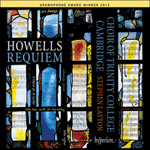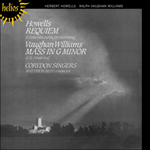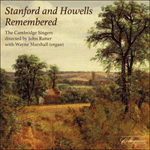Not released for publication until 1980, the
Requiem for unaccompanied voices, an exquisite and deeply personal expression of loss in which appears much of the material that was eventually to be expanded and reworked into
Hymnus Paradisi, was initially thought to be a first draft of that work, composed soon after Michael Howells’ death in 1935. However, the researches of Howells’ biographer Christopher Palmer soon revealed that the
Requiem was in fact composed in 1932, some three years before Michael died, and was modelled on a little-known work,
A short Requiem in D major composed in 1915 by Walford Davies, one of Howells’ earliest teachers at the Royal College of Music, in memory of those killed in the war. Howells drew on this work first of all for its selection and ordering of texts, which he adopted almost without change. The only difference is that Davies set Psalm 130 where Howells has Psalm 23. It is an unconventional and original structure drawing on the Burial Service in the Book of Common Prayer, the Latin Requiem Mass, and the Psalms. But Davies’ work was more than just a template for the words. The musical structure of both works is very similar. Both composers set ‘Salvator mundi’, ‘Requiem aeternam (I) and (II)’ and ‘Audi vocem’ (‘I heard a voice from heaven’) in a more extended and complex way than the Psalms, which Davies sets to Anglican chants of his own composing, and Howells to simpler, more syllabic music. Similarities also extend to the structure of phrases and verbal rhythm, most markedly in ‘I heard a voice from heaven’, where the rhythm of Howells’s opening tenor solo matches almost exactly that of Davies’ baritone in ‘Audi vocem’. But these similarities are of course superficial. Howells may have had Walford Davies’ work in front of him as he planned his own
Requiem, but Davies’ workmanlike music is transmuted into pure Howellsian gold. This is a wonderful, heart-aching work of searing beauty. It may not have been written as a direct response to personal loss, but it is scarcely surprising that it was to this work that Howells returned just a few years later to find both the structure and much of the musical material he needed to make his own response to the deepest, most profound loss of his life.
from notes by Paul Andrews © 2012
Publié seulement en 1980, le
Requiem pour voix sans accompagnement, expression parfaite et profondément personnelle de perte, où figure une grande partie du matériel qui allait finalement être développé et retravaillé dans
Hymnus Paradisi, a été quelque temps considérée comme une première ébauche de cette œuvre, composée peu après la mort de Michael Howells en 1935. Toutefois, les recherches du biographe de Howells, Christopher Palmer, ont vite révélé que le
Requiem avait été composé en fait en 1932, trois ans avant la mort de Michael, sur le modèle d’une œuvre peu connue,
A short Requiem en ré majeur composé en 1915 à la mémoire des morts à la guerre par Walford Davies, l’un des premiers professeurs de Howells au Royal College of Music. Howells s’est inspiré de cette œuvre avant tout pour le choix et l’ordre des textes, qu’il a adoptés sans changement ou presque. La seule différence, c’est que Davies a mis en musique le Psaume 130 là où Howells a choisi le Psaume 23. C’est une structure peu conventionnelle et originale qui puise dans le service funèbre du Book of Common Prayer, la Messe latine de Requiem et les Psaumes. Mais l’œuvre de Davies n’a pas seulement été un modèle pour les textes. La structure musicale des deux œuvres est très semblable. Les deux compositeurs ont mis en musique «Salvator mundi», «Requiem aeternam (I) et (II)» et «Audi vocem» («I heard a voice from heaven», «J’ai entendu une voix venant du ciel») d’une manière plus étendue et complexe que les Psaumes, que Davies a mis en musique sur des chants anglicans de sa composition et Howells sur une musique plus simple, plus syllabique. Les similitudes s’étendent aussi à la structure des phrases et au rythme verbal, de façon très marquée dans «I heard a voice from heaven», où le rythme du solo initial du ténor chez Howells correspond presque exactement à celui du baryton chez Davies dans «Audi vocem». Mais ces ressemblances sont bien sûr superficielles. Howells avait peut-être l’œuvre de Walford Davies devant lui en préparant son propre
Requiem, mais la musique soignée de Davies est transmuée en or pur sous la plume de Howells. C’est une œuvre magnifique, douloureuse, d’une beauté saisissante. Elle n’a peut-être pas été écrite directement en réponse à une perte personnelle, mais il n’est guère surprenant que Howells soit revenu à cette œuvre quelques années plus tard pour trouver à la fois la structure et une grande partie du matériel musical dont il avait besoin pour exprimer sa propre réponse à la perte la plus grande et la plus profonde de sa vie.
extrait des notes rédigées par Paul Andrews © 2012
Français: Marie-Stella Pâris
Das
Requiem für Gesang a cappella wurde erst 1980 zur Veröffentlichung freigegeben. Das Werk, ein herausragender und sehr persönlicher Ausdruck des Verlustes, wurde zunächst für einen Entwurf von
Hymnus Paradisi gehalten und enthält viele Ideen, die in erweiterter und überarbeiteter Form dort erscheinen. Die Untersuchungen von Christopher Palmer, dem Biografen Howells, zeigten jedoch schnell, dass das
Requiem schon 1932 komponiert wurde, rund drei Jahre vor dem Tod von Howells Sohn Michael (
Hymnus Paradisi enstand kurz danach) und dass es einem relativ unbekannten Werk nachempfunden ist, nämlich
A short Requiem in D-Dur von Walford Davies. Walford Davies war einer der ersten Kompositionslehrer von Howells am Royal College of Music, der es 1915 im Gedenken an die Gefallenen des Krieges geschrieben hatte. Howells nutzte diese Vorlage vor allem in Bezug auf Auswahl und Anordnung der Texte, die er fast unverändert übernahm. Der einzige Unterschied besteht darin, dass Howells den 23. Psalm statt wie Davies den 130. Psalm vertonte. Die unkonventionelle und einfallsreiche Zusammenstellung greift auf die Bestattungsliturgie des anglikanischen Book of Common Prayer, die lateinische Totenmesse und die Psalmen zurück. Davies’ Werk diente jedoch nicht nur als Textvorlage. Auch die musikalische Gliederung beider Werke ist sehr ähnlich. Bei beiden Komponisten sind das „Salvator mundi“, das „Requiem aeternam (I) und (II)“ sowie das „Audi vocem“ („I heard a voice from heaven“) ausgedehnter und komplexer gestaltet als die Psalmen; letztere vertont Davies im Stil der mehrstimmigen, anglikanischen Psalmodie, Howells hingegen in schlichterer und stärker syllabischer Form. Die Parallelen erstrecken sich auch auf die Gestaltung von Phrasen und Wortrhythmus, am deutlichsten in „I heard a voice from heaven“, dessen Soloauftakt für Tenor bei Howells rhythmisch fast vollständig mit dem Bariton in Davies’ „Audi vocem“ übereinstimmt. Doch sind solche Ähnlichkeiten natürlich oberflächlich. Howells mag das Werk von Walford Davies beim Entwurf seines eigenen
Requiems vor sich gehabt haben, doch verwandelt sich Davies’ musikalische Handwerksarbeit bei Howells zu purem Gold. Dies ist ein herrliches Werk voll Herzensqual und schmerzlicher Schönheit. Auch wenn es nicht als unmittelbare Reaktion auf einen persönlichen Verlust entstanden sein mag, verwundert es kaum, dass Howells wenige Jahre später gerade auf dieses Werk zurückkam, um ihm sowohl den Aufbau als auch viele der musikalischen Gedanken zu entlehnen, die er für seine Antwort auf den einschneidendsten und erschütterndsten Verlust seines Lebens benötigte.
aus dem Begleittext von Paul Andrews © 2012
Deutsch: Arne Muus



 A prayer for deliverance
A prayer for deliverance Howells: Requiem & other choral works
Howells: Requiem & other choral works Howells: Requiem; Vaughan Williams: Mass in G minor
Howells: Requiem; Vaughan Williams: Mass in G minor Stanford and Howells Remembered
Stanford and Howells Remembered
